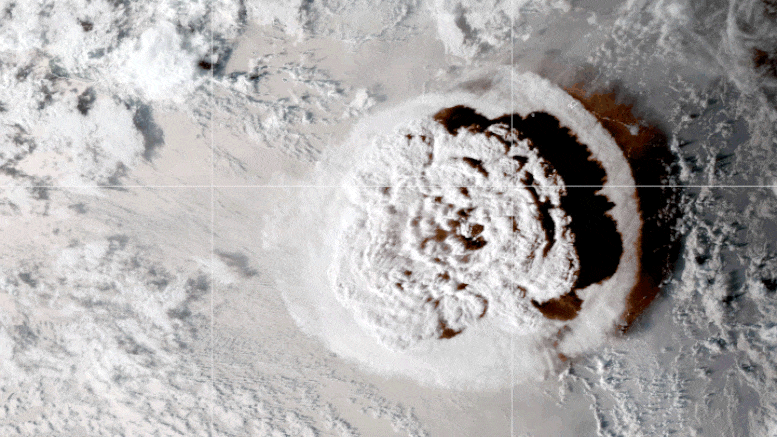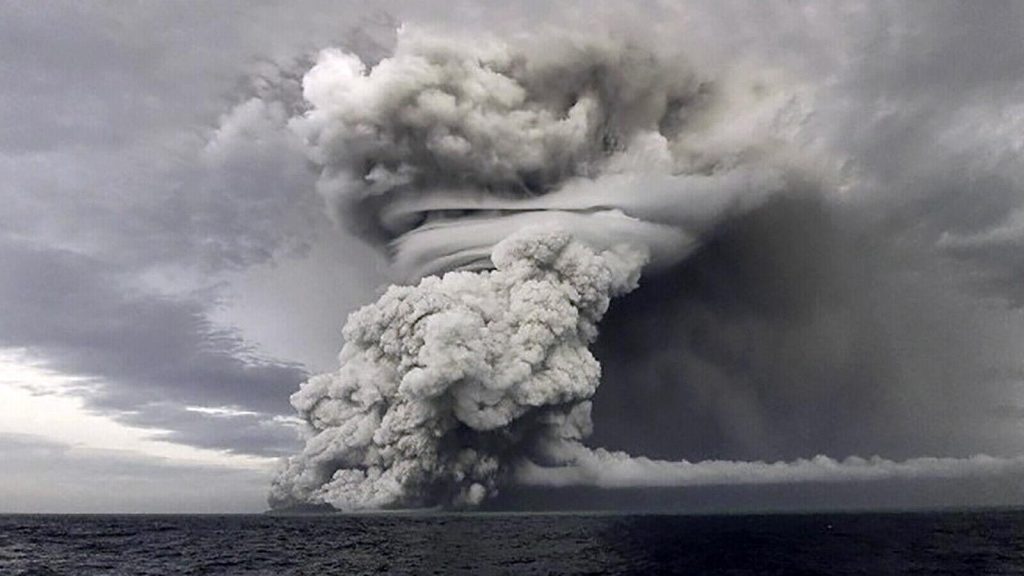Hunga Tonga volcano photographed during its eruption on 14-15 January 2022. Photo credit: Tonga Geological Service / ZUMA Press / Zuma / RÉA (Courtesy of Dr. Mark Schoebel)
Although widely believed to be responsible for the extreme warming of the planet over the past two years, researchers say the Hunga Tonga eruption actually cooled the climate.
A study from Texas A&M University investigated the climate impacts of the 2022 eruption of Hunga Tonga volcano and found that it caused a cooling rather than a warming event, contradicting conventional thinking and highlighting the need for continued collection of satellite data to understand climate dynamics, and supporting the primary role of anthropogenic emissions in climate change.
A collaborative research team, including atmospheric scientist Dr. Andrew Dessler from Texas A&M University, is investigating the climate impacts of the 2022 eruption of Hunga Tonga volcano while simultaneously questioning previous assumptions about those effects.
of Highlights of the two-day eventThe eruption of Hunga Tonga volcano in mid-January 2022 released a large amount of volcanic aerosols and water vapor into the atmosphere. Historically, large volcanic eruptions such as Mount Tambora in 1815 and Mount Pinatubo in 1991 have had a significant cooling effect on the Earth’s climate by blocking sunlight with aerosols. However, the Hunga Tonga eruption presented a unique scenario. As a submarine volcano, it released an unprecedented amount of water vapor into the stratosphere, increasing the total stratospheric water content by about 10%.
Because water vapor is a powerful greenhouse gas, Dessler said, it was initially assumed that it would be the cause of the extreme global warming in 2023 and 2024. But the team’s findings, published July 24, suggest that Journal of Geophysical Research: Atmospherereveals the opposite: the eruption is actually cooling This phenomenon, like other large-scale volcanic activity, is occurring on Earth.

The GOES-17 satellite captured this image of an umbrella cloud produced by an underwater eruption of the Hungatonga-Hungahaapai volcano on January 15, 2022. A crescent-shaped bow shock wave and numerous lightning strikes are also visible. Credit: Image by NASA Earth Observation Satellite Joshua Stevens, GOES image courtesy of NOAA and NESDIS
The cooling effect of volcanic eruptions
The team’s paper, titled “Evolution of Climate Forcing Two Years Following the Hunga Tonga Hunga Ha’apai Eruption,” includes insights and analysis from Dessler, professor of atmospheric sciences at Texas A&M University and director of the Texas Climate Research Center; lead author Dr. Mark Schaubel, principal scientist at the Virginia Science and Technology Corporation in Hamburg, Virginia; and several scientists at the Texas Meteorological Laboratory. National Aeronautics and Space Administration (NASA).
Their methodology is analytical. National Aeronautics and Space Administration (NASA) and National Oceanic and Atmospheric Administration (NOAA) The team estimated the energy balance of the Earth’s climate system from satellite data observations of aerosols, water vapor, etc. Their analysis revealed that the energy released from the climate system due to the eruption exceeded the energy input, causing a slight cooling effect.
“Our paper throws cold water on explanations that suggest an eruption caused the unusually hot weather in 2023 and 2024,” Dessler explained. “Instead, we should focus primarily on greenhouse gases from human activities as the main cause of the warming, with a major help from the ongoing El Niño event.”
Implications and future research
According to Dessler, the study has important implications for both scientists and the general public. By rejecting volcanic eruptions as the primary driver of recent warming, the team’s study strengthens Dessler’s argument that human-induced greenhouse gas emissions are the primary cause of climate change. This focus is especially important given the ongoing debate and misinformation about the causes of global warming.
Additionally, Schaubel said, the study highlights the importance of continued investment in satellite-based stratospheric measurements.
“Our understanding of the Hungatonga eruption is largely due to investments in stratospheric satellite measurements. National Oceanic and Atmospheric Administration “For the past 20 years, NASA and the National Aeronautics and Space Administration have faced the threat of a stratospheric data desert,” Schaubell added, “but we need to be careful of a potential ‘stratospheric data desert’ because some of our most important instruments have not been replaced.”
Unanswered questions and the way forward
The paper answers some important questions, but Dessler acknowledges that it also raises new ones. For example, the researchers highlighted several unresolved issues related to the Hunga Tonga eruption, such as the unexpectedly low amount of sulfur dioxide produced by such a violent eruption and the minimal impact the eruption had on the 2023 ozone hole. The 2023 ozone hole refers to a significant thinning of the ozone layer over Antarctica, which allows more harmful ultraviolet radiation to reach the Earth’s surface. In addition, the persistence of stratospheric water vapor beyond model predictions suggests that there is still a lot to learn about stratospheric circulation processes.
As scientists work to answer ongoing questions and improve our understanding of the stratosphere, Schaubel said the team’s work highlights the need for continued research and accurate data to meet the challenges of climate change.
Reference: MR Schoeberl, Y. Wang, G. Taha, DJ Zawada, R. Ueyama, A. Dessler, “Evolution of climate forcing two years after the Hunga Tonga Hunga Ha’apai eruption,” 24 July 2024; Journal of Geophysical Research: Atmosphere.
Posted on: 10.1029/2024JD041296


